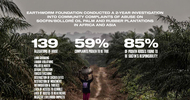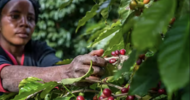Gecko Project | 9 Ocotber 2019
Saving Aru: The epic battle to save the islands that inspired the theory of evolution
This story was co-published with Mongabay. Additional support was provided by Earthsight.
Part One: The movement begins
Late one rainy night in August 2013, a college student named Collin Leppuy arrived at the doorstep of Father Jacky Manuputty, a church minister in the coastal city of Ambon, Indonesia. He had come to ask for help; his homeland was under threat.
Collin, then 23, had grown up in the Aru Islands, a heavily forested archipelago in the eastern margins of the world’s largest island nation. He was studying social welfare policy at a university in Ambon, the capital of Maluku province. Collin had recently organized rallies in the city against a corrupt politician who had governed Aru for nearly a decade. Convicted of siphoning off millions of dollars in state funds, the politician had absconded before law enforcers finally caught up with him. Collin had felt proud of the outcome, but this gave way to a renewed sense of urgency when he discovered what else the politician had done before his arrest.
For decades, Aru had escaped the attention of the companies clearing Indonesia’s rainforests. But as the jungles of Java, Sumatra and Borneo dwindled, those in search of timber and agricultural land began to look east. Aru now lay in the sights of a company called the Menara Group. Collin had learned that before he was ousted from office, the politician had secretly approved a plan by Menara to plant sugarcane across nearly two-thirds of Aru. If it went ahead, the firm would reap billions of dollars by logging Aru’s forests and replacing them with what could be the world’s biggest sugar plantation. But it would destroy the existing livelihoods and food supplies of tens of thousands of people, including Collin’s friends and family. It would ruin the habitats of Aru’s unique wildlife, of animals like the ethereal birds-of-paradise, and the natural world from which the Aruese drew their identity.
Read the full story at The Gecko Project website
Saving Aru: The epic battle to save the islands that inspired the theory of evolution
This story was co-published with Mongabay. Additional support was provided by Earthsight.
Part One: The movement begins
Late one rainy night in August 2013, a college student named Collin Leppuy arrived at the doorstep of Father Jacky Manuputty, a church minister in the coastal city of Ambon, Indonesia. He had come to ask for help; his homeland was under threat.
Collin, then 23, had grown up in the Aru Islands, a heavily forested archipelago in the eastern margins of the world’s largest island nation. He was studying social welfare policy at a university in Ambon, the capital of Maluku province. Collin had recently organized rallies in the city against a corrupt politician who had governed Aru for nearly a decade. Convicted of siphoning off millions of dollars in state funds, the politician had absconded before law enforcers finally caught up with him. Collin had felt proud of the outcome, but this gave way to a renewed sense of urgency when he discovered what else the politician had done before his arrest.
For decades, Aru had escaped the attention of the companies clearing Indonesia’s rainforests. But as the jungles of Java, Sumatra and Borneo dwindled, those in search of timber and agricultural land began to look east. Aru now lay in the sights of a company called the Menara Group. Collin had learned that before he was ousted from office, the politician had secretly approved a plan by Menara to plant sugarcane across nearly two-thirds of Aru. If it went ahead, the firm would reap billions of dollars by logging Aru’s forests and replacing them with what could be the world’s biggest sugar plantation. But it would destroy the existing livelihoods and food supplies of tens of thousands of people, including Collin’s friends and family. It would ruin the habitats of Aru’s unique wildlife, of animals like the ethereal birds-of-paradise, and the natural world from which the Aruese drew their identity.
Read the full story at The Gecko Project website













